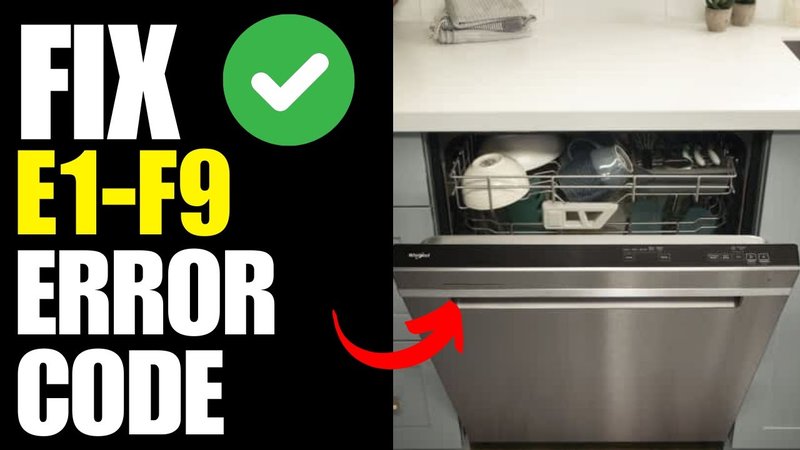
Understanding the Error Code E1 on Whirlpool Dishwashers
When your Whirlpool dishwasher flashes an E1 error code, it’s trying to communicate a problem related to the water supply. Think of it like a clogged faucet; the water just isn’t flowing as it should. This code typically suggests that the dishwasher isn’t getting the right amount of water to operate effectively. This can happen for a variety of reasons, such as a kink in the water supply hose or issues with water pressure.
Now, you might be wondering, “Why is water flow so important?” Well, adequate water supply ensures that your dishwasher can successfully clean your dishes. Without enough water, you might end up with partially cleaned plates or worse, a burned-out motor from trying to operate under stress. So, while E1 might seem like a minor inconvenience at first, it actually hints at underlying issues that could affect your dishwasher’s performance.
Ignoring the E1 error might not cause immediate problems, but it could lead to inefficiencies like longer washing cycles or ineffective cleaning, translating to more headaches for you. It’s a bit like driving a car with a flat tire—you might get by for a while, but eventually, it’ll lead to more trouble. Instead of risking further complications, it’s wise to address the problem sooner rather than later.
Common Causes of the E1 Error Code
You might be curious, “What causes the E1 error code to appear?” In many cases, it’s simply due to a water supply issue. Imagine trying to fill a cup from a trickle rather than a full flow—your dishwasher experiences the same struggle. The most common culprits include blocked filters, clogged water inlet valves, or even an issue with the home’s water pressure.
A blocked filter can prevent water from entering the dishwasher, much like how a blocked sink won’t drain properly. Checking and cleaning the filter might resolve the issue. Similarly, if the water inlet valve is blocked or doesn’t open correctly, it could restrict the flow of water. This blockage might be caused by debris or simply wear and tear over time. Lastly, if your home experiences low water pressure, it’s like trying to water your garden with a leaky hose—inefficient and frustrating.
Addressing these causes often involves some basic troubleshooting. Make sure the water supply line is clear and free of kinks. Clean the filters and check the valve for any visible obstructions. If these steps don’t resolve the issue, it might be time to consult a professional or consider replacing faulty parts.
Steps to Fix the E1 Error Code
So, how do you fix this pesky error? Here’s the deal—start by turning off the dishwasher and inspecting the water supply line. Ensure there are no kinks or obstacles that could hinder water flow. Once that’s clear, the next step is to examine the filters. These can often be located at the bottom of the dishwasher, and if they’re clogged, a simple rinse under warm water may do the trick.
If cleaning the filters doesn’t help, it’s worth checking the water inlet valve. A malfunctioning valve could require replacement—a task that might be best left to a professional unless you feel confident in your DIY skills. Sometimes, the issue might not be with the dishwasher at all but with the water pressure in your home. If this is the case, consulting with a plumber could provide a longer-term fix.
These steps might seem like a bit of a hassle, but they’re crucial for ensuring your dishwasher runs smoothly. Taking a proactive approach can save you time and money in the long run, preventing more significant issues from developing down the line.
Preventative Measures to Avoid Future Error Codes
Wondering how to keep that E1 error at bay? Like any machine, dishwashers benefit from regular maintenance. Regularly clean the filters to prevent build-up, much like brushing your teeth to avoid cavities. Also, monitor the water supply line for any signs of wear or kinks—think of it as regularly checking your tire pressure.
Another useful tip is to run your dishwasher periodically, even when it’s not full. This practice helps keep the system functioning correctly and can flush out minor blockages before they become significant problems. Additionally, keeping an eye on your home’s water pressure can prevent other appliance-related issues.
By maintaining your dishwasher and addressing minor issues as they arise, you’re investing in its long-term health and efficiency. The E1 code might seem daunting at first, but with a bit of attention and care, you can keep your trusty appliance running smoothly for years to come.
In conclusion, while the E1 error code may seem like a small issue, it’s one you shouldn’t ignore. Addressing it sooner rather than later ensures your dishwasher remains an invaluable helper in your kitchen rather than a source of stress. If in doubt, don’t hesitate to reach out to a professional for help. After all, a smoothly running dishwasher means one less thing to worry about in your busy life.